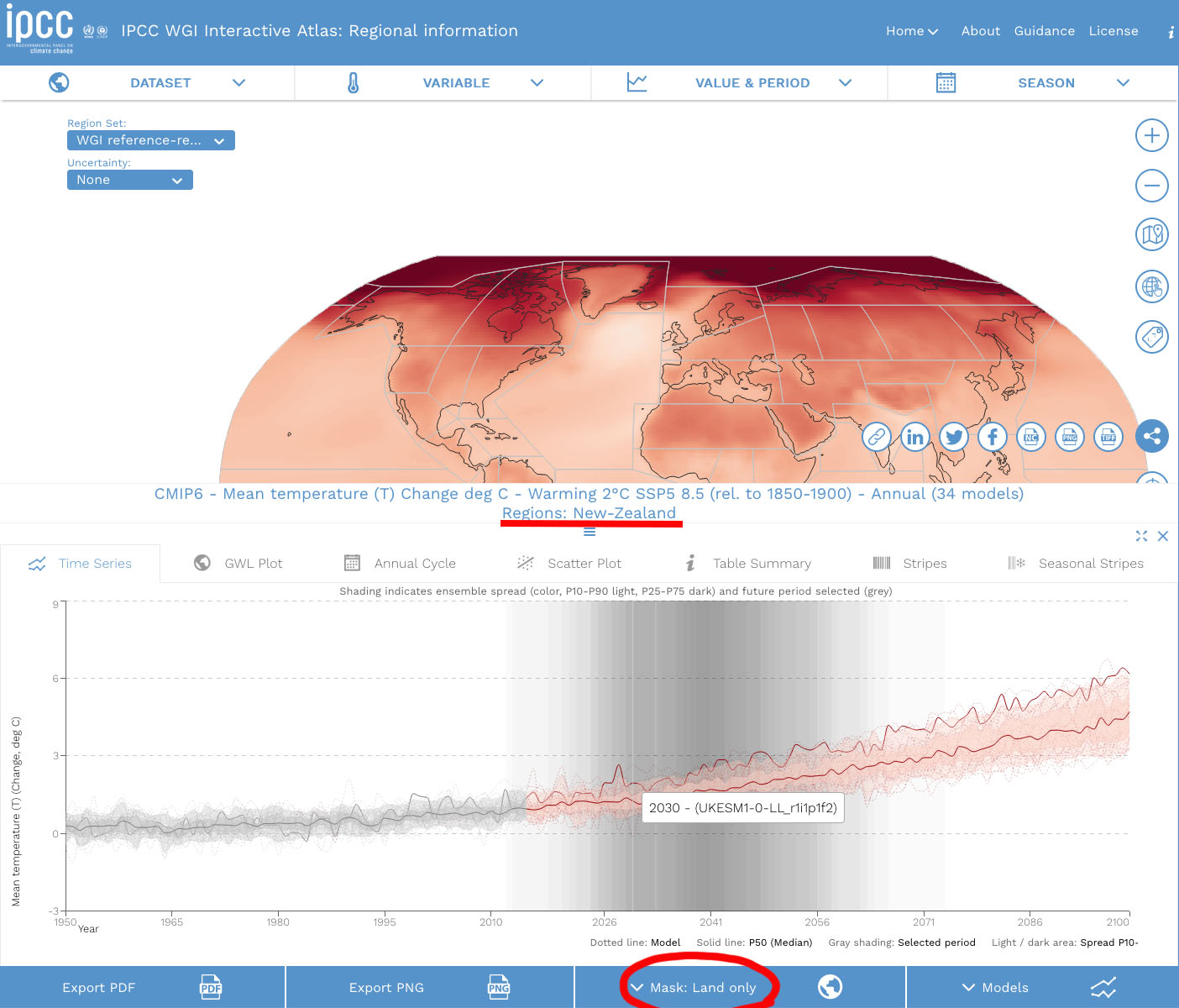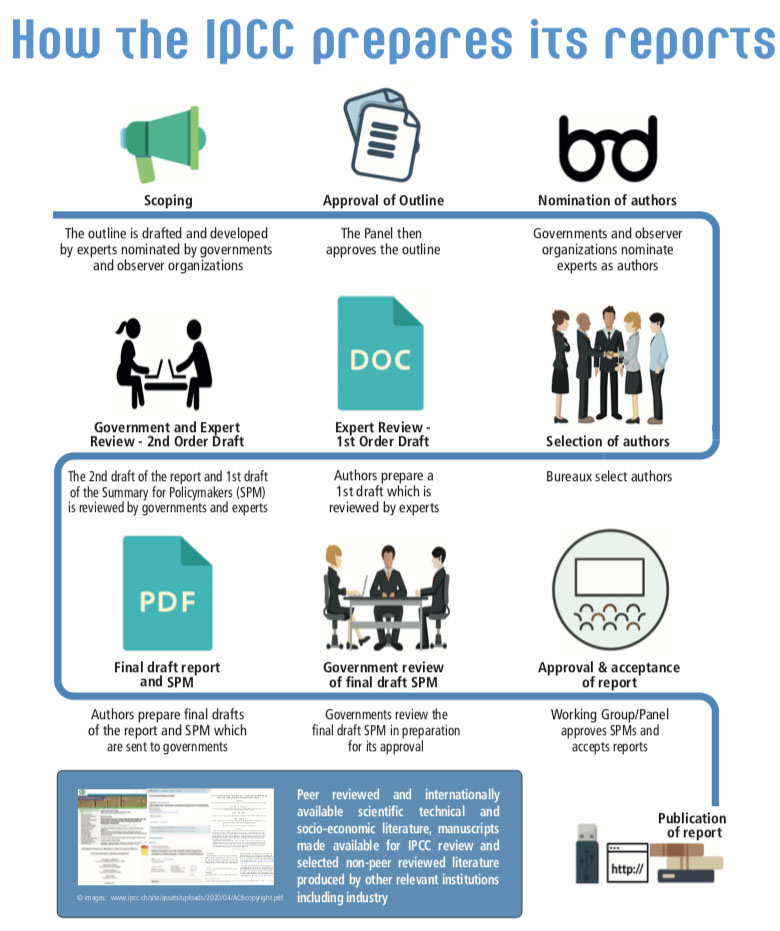Image: IPCC
Sixth Assessment Report 2021-22
“I’ve seen many scientific reports in my time but nothing like this. Today’s IPCC report is an atlas of human suffering and the damning indictment of failed climate leadership. This report reveals that all people on the planet are getting clobbered by climate change. Nearly half of humanity is living in the danger zone. Now. Many ecosystems are at the point of no return. Now. And unchecked carbon pollution is forcing the globe’s most vulnerable on a frog march to destruction. Now. The facts are undeniable. This abdication of leadership is criminal.” – António Guterres, Secretary-General of the United Nations introduction to the IPCC Sixth Assessment Report II: Impacts, Adaptation and Vulnerability
Background
Back in 1988 when it was clear that the world’s climate was changing, it was also evident that every aspect of life on Earth would be affected. The IPCC was formed to gather research from around the world, evaluate it, and use it to make predications about the impacts, with the objective of ‘stablising greenhouse gas concentrations in the atmosphere at a level that would prevent dangerous anthropogenic (human-induced) interference with the climate system‘. By gathering research from across all sectors, the IPCC is also able to see where there are gaps in knowledge, which in turn helped direct research.
Each of the six Assessment Reports published since 1988 runs into several million words, are in several parts, and collated over four to five years by scientists and researchers nominated by their respective governments (Fig. 2). This process ensures that:
- All member nations are represented
- There is time to include all relevant material
- A consensus is reached by all nations prior to each Assessment Report being released
Thousands of scientists and other experts around the world volunteer their time to write and review the draft reports. As these are long and technical, to ensure the research is robust and comprehensive, there is also a summary report for policymakers. Delegates from all participating governments—around 120 including New Zealand—check the summary report line-by-line, and all countries have to agree on the wording before the final report is published.
The Sixth Assessment Report (AR6) is in three parts authored by working groups (WG):
- August 2021: AR6 WG1 The physical Science
- February 2022: AR6 WG2 Impacts, Adaptation and Vulnerability
- April 2022: AR6 WG3 Mitigation of Climate Change
Criticisms of reports being too conservative
Some assumptions in the first five assessment cycles (AR1-5) have not come to pass. These assumptions were primarily that:
- Once governments knew the problems that climate change would bring, they would act quickly to replace fossil fuels. This is failing.
- Carbon capture technologies would be invented and installed to remove excess greenhouse gases from the atmosphere. The technology exists but is not cost effective and most tech sells the CO2 as fuel, returning it back into the atmosphere.
Some nations still reject aspects of the science and implications of climate change, insisting on language in the summary reports downplay the scale and urgency of the problems. As few policy makers read more than the summary reports, the nuances are often lost or overlooked.
Supporting evidence: It takes years to gather robust data, write research papers and have that research published. Consequently, some research in IPCC reports is more than a decade old.
In research fields such as the process that lead to ice-caps melting, it was (and still is) an evolving field of science, and so summary reports did not include the potential of this to lead to rapid sea level rise, because it was an unknown. Hence, by the time IPCC reports are released, real-world events and discoveries have already taken place.
For example, IPCC predictions about sea level rise and temperatures regarded the ‘worst case scenario’ to be the ‘least likely’. On the eve of the Fourth Assessment Report a study was published showing that temperatures were at the top end of the worst predictions (blue-dotted line), and sea levels were rising much faster that the ‘worst case’ scenario (grey shaded area) (Fig. 3).
This problem of a lack of data and out-dated research is crucial, given that data in the 2013 Fifth Assessment Report used as the basis of the 2015 Paris Agreement to keep global temperatures under 1.5°C was itself based on research as much as 10 year old. AR6 WG1 The physical Science presented catastrophic evidence, and yet modelling of sea level rise still did not include rapid melting processes being observed in Greenland and Antarctica as there wasn’t (and still isn’t) sufficient data to calculate what this could look like for sea level rise.
More information
-
 RCP or Representative Concentration Pathway, is a way of showing the path our climate would take based on the concentration of greenhouse gases in the atmosphere. Four credible pathways, RCP2.6, RCP4.5, RCP6, and RCP8.5 represent four possible ranges of radiative forcing values: 2.6, 4.5, 6, and 8.5 Watts/m2, respectively. The numbers refer to the effect of heat retained in the atmosphere due to actual concentrations of greenhouse gases, not the amount of emissions that put them there, because the natural carbon cycle absorbs a percentage of carbon emissions.The term RCP was adopted by the IPCC for climate modeling and research for the fifth assessment report in 2014.The researchers who developed the RCP 8.5 scenario describe the pathway in detail here.
RCP or Representative Concentration Pathway, is a way of showing the path our climate would take based on the concentration of greenhouse gases in the atmosphere. Four credible pathways, RCP2.6, RCP4.5, RCP6, and RCP8.5 represent four possible ranges of radiative forcing values: 2.6, 4.5, 6, and 8.5 Watts/m2, respectively. The numbers refer to the effect of heat retained in the atmosphere due to actual concentrations of greenhouse gases, not the amount of emissions that put them there, because the natural carbon cycle absorbs a percentage of carbon emissions.The term RCP was adopted by the IPCC for climate modeling and research for the fifth assessment report in 2014.The researchers who developed the RCP 8.5 scenario describe the pathway in detail here.The IPCC sixth assessment report (2021) used instead the term Shared Socioeconomic Pathways (SSPs). These are scenarios of projected socio-economic global changes up to 2100. That is, how different policies around greenhouse gas emissions will result in different outcomes. The following explanation is from the 2019: FINAL DRAFT Chapter 1 Supplementary Material IPCC SR Ocean and Cryosphere, Chapter 1: Framing and Context of the Report Supplementary Material (page 7):
“Five SSP narratives describe alternative pathways for future society (Figure SM1.1). Each SSP looks at how the different RCPs could be achieved within the context of the underlying socioeconomic characteristics and shared policy assumptions of that world. The SSPs five alternative socio-economic futures compromise: sustainable development (SSP1), middle-of-the-road development (SSP2), regional rivalry (SSP3), inequality (SSP4), and fossil-fuelled development (SSP5) (Kriegler et al., 2016; Riahi et al., 2017). Across these five SSP narratives there are a total of 23 ‘Marker’ SSP scenarios. Appendix 1.A, Figure 2 shows some specific SSP Markers compared with the RCPs, according to (O’Neill et al., 2016). SSP5-8.5 represents the high end of the range of future pathways, corresponding to RCP8.5. SSP3-7.0 lies between RCP6.0 and RCP8.5, and represents the medium to high end of the range of future forcing pathways. SSP4-6.0 corresponds to RCP6.0, fills in the range of medium forcing pathways. SSP2-4.5 represents the medium part of the range of future forcing pathways and updates RCP4.5. SSP5-3.4 (Overshoot) fills a gap in existing climate simulations by investigating the implications of a substantial 21st century overshoot in radiative forcing relative to a longer-term target. SSP4-3.4 fills in the range of low forcing pathways, and there is substantial mitigation policy interest in this scenario that reaches 3.4 W m–2 by \] 2100. SSP1-2.6 is similar to RCP2.6. It is anticipated that it will produce a multi-model mean of less than 2°C warming by 2100.” –
SSP1: Sustainability: The world shifts gradually but consitently toward a more sustainable path, with net zero emissions by 2050
SSP2: Low emissions: Emissions decline to net zero by 2050
SSP3: Regional rivalry: resurgent nationalism, conflicts, less investment in education and technological development, consumption is material-intensive, and inequalities persist or worsen over time. Emission stay at current levels and fail to reach net zero by 2100
SSP4: Inequality: increasing conflict and decreasing global co-operation. Social cohesion degrades and conflict and unrest become increasingly common. Investments in both carbon-intensive fuels like coal and unconventional oil, but also low-carbon energy sources. Environmental policies focus on local issues around middle and high income areas. ie, the wealthy are protected. Emissions double by 2100
SSP5: Fossil-Fueled Development: increasing faith technological ‘fixes’ to manage social and ecological systems, including by geo-engineering if necessary. Emissions triple by 2075.Both SSP 1 and 2 now appear unlikely. Our current emissions pathway (Jan. 2023) is SSP5-8.5. This may yet change over time.





